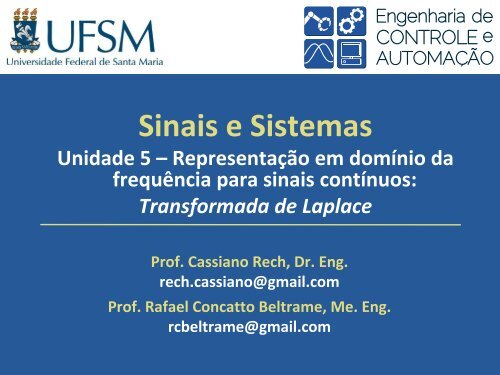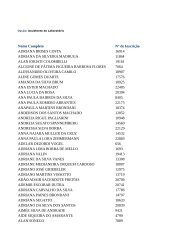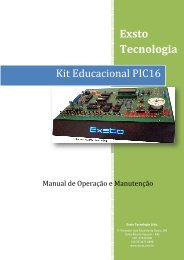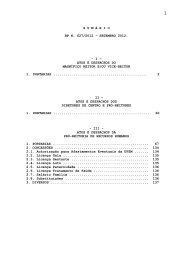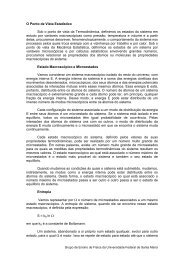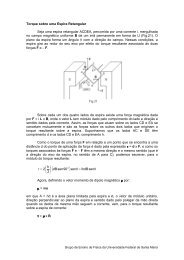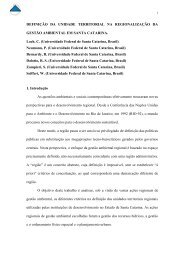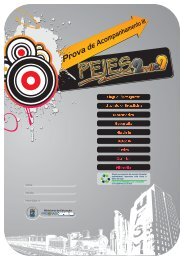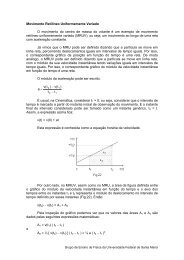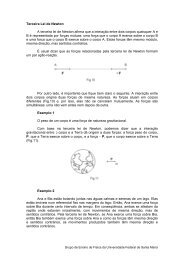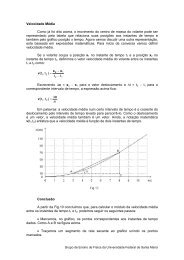Respostas no Domínio da Frequência (Aula 01) - UFSM
Respostas no Domínio da Frequência (Aula 01) - UFSM
Respostas no Domínio da Frequência (Aula 01) - UFSM
You also want an ePaper? Increase the reach of your titles
YUMPU automatically turns print PDFs into web optimized ePapers that Google loves.
Sinais e Sistemas<br />
Uni<strong>da</strong>de 5 – Representação em domínio <strong>da</strong><br />
frequência para sinais contínuos:<br />
Transforma<strong>da</strong> de Laplace<br />
Prof. Cassia<strong>no</strong> Rech, Dr. Eng.<br />
rech.cassia<strong>no</strong>@gmail.com<br />
Prof. Rafael Concatto Beltrame, Me. Eng.<br />
rcbeltrame@gmail.com
Conteúdo <strong>da</strong> uni<strong>da</strong>de<br />
•<br />
•<br />
•<br />
•<br />
•<br />
•<br />
•<br />
•<br />
•<br />
•<br />
Introdução<br />
Definição <strong>da</strong> Transforma<strong>da</strong> de Laplace<br />
Solução de equações diferenciais lineares<br />
e invariante <strong>no</strong> tempo<br />
Função de Transferência<br />
Conceito de pólos e zeros<br />
Estabili<strong>da</strong>de de sistemas<br />
Sistemas com atraso de transporte<br />
Análise <strong>da</strong> resposta transitória<br />
Análise <strong>da</strong> resposta em regime permanente<br />
Resposta em frequência e Diagrama de Bode<br />
Prof. Cassia<strong>no</strong> Rech, Dr. Eng. | Prof. Rafael Concatto Beltrame, Me. Eng.<br />
<strong>Aula</strong>s<br />
<strong>Aula</strong> 03<br />
<strong>Aula</strong> 04<br />
<strong>01</strong> e 02<br />
<strong>Aula</strong>s 05 e 06<br />
1/5<br />
2
<strong>Aula</strong> 05<br />
•<br />
Resposta em frequência e Diagrama de Bode<br />
–<br />
–<br />
–<br />
–<br />
–<br />
Introdução<br />
Definição de módulo de fase<br />
Representação na forma de Bode<br />
Digramas de Bode<br />
• Ganho K<br />
• Fatores integral e derivativo (s) ±1<br />
• Fatores de primeira ordem (s + 1) ±1<br />
• Fatores quadráticos (s² + 2ζs/ωn + 1)<br />
Procedimento geral para construção<br />
Prof. Cassia<strong>no</strong> Rech, Dr. Eng. | Prof. Rafael Concatto Beltrame, Me. Eng.<br />
±1<br />
1/5<br />
3
Introdução<br />
•<br />
Hendrik<br />
–<br />
–<br />
–<br />
–<br />
–<br />
–<br />
Wade<br />
Bode<br />
America<strong>no</strong> (1905‐1982)<br />
Engenheiro, pesquisador e inventor<br />
Pioneiro em<br />
• Teoria de controle (aplica<strong>da</strong> à aviação)<br />
• Telecomunicações<br />
Em 1929 entra para o Bell Labs<br />
Em 1938 desenvolve o método gráfico<br />
conhecido como Diagrama de Bode<br />
• Análise gráfica de ganho e fase de sistemas<br />
Ganhou diversos prêmios por suas contribuições científicas<br />
Prof. Cassia<strong>no</strong> Rech, Dr. Eng. | Prof. Rafael Concatto Beltrame, Me. Eng.<br />
1/5<br />
4
Introdução<br />
•<br />
Resposta em frequência<br />
–<br />
–<br />
–<br />
Resposta em regime estacionário de um sistema submetido a um sinal<br />
de entra<strong>da</strong> se<strong>no</strong>i<strong>da</strong>l<br />
Varia‐se a frequência do sinal de entra<strong>da</strong> ao longo de uma faixa de<br />
interesse e estu<strong>da</strong>‐se a resposta resultante<br />
A resposta em frequência pode ser obti<strong>da</strong> experimentalmente<br />
empregando geradores de sinal se<strong>no</strong>i<strong>da</strong>l e equipamentos de medi<strong>da</strong><br />
de precisão<br />
Prof. Cassia<strong>no</strong> Rech, Dr. Eng. | Prof. Rafael Concatto Beltrame, Me. Eng.<br />
1/5<br />
5
Resposta em regime para sinal se<strong>no</strong>i<strong>da</strong>l<br />
•<br />
Seja um sistema LTI definido por<br />
–<br />
–<br />
–<br />
<br />
G s<br />
Onde o sinal de entra<strong>da</strong> x(t) ése<strong>no</strong>i<strong>da</strong>l e <strong>da</strong>do por<br />
Se o sistema for estável, o sinal de saí<strong>da</strong> y(t), em regime estacionário,<br />
será <strong>da</strong>do por<br />
Onde<br />
<br />
<br />
<br />
Y s<br />
X s<br />
xtXsenωt ytYsenωtφ Y X Gjω e <br />
Prof. Cassia<strong>no</strong> Rech, Dr. Eng. | Prof. Rafael Concatto Beltrame, Me. Eng.<br />
<br />
<br />
ImG jω <br />
φ G jωarctg <br />
<br />
<br />
<br />
ReG jω <br />
<br />
1/5<br />
6
Resposta em regime para sinal se<strong>no</strong>i<strong>da</strong>l<br />
•<br />
Observações<br />
–<br />
–<br />
Um sistema LTI submetido a uma excitação se<strong>no</strong>i<strong>da</strong>l, terá como<br />
resposta, em regime estacionário, um sinal também se<strong>no</strong>i<strong>da</strong>l de<br />
mesma frequência<br />
A amplitude e o ângulo (fase) do sinal de saí<strong>da</strong> são, em geral,<br />
diferentes do sinal de entra<strong>da</strong><br />
Prof. Cassia<strong>no</strong> Rech, Dr. Eng. | Prof. Rafael Concatto Beltrame, Me. Eng.<br />
1/5<br />
7
Resposta em regime para sinal se<strong>no</strong>i<strong>da</strong>l<br />
•<br />
Função de transferência se<strong>no</strong>i<strong>da</strong>l<br />
–<br />
–<br />
–<br />
–<br />
A função de transferência se<strong>no</strong>i<strong>da</strong>l de qualquer sistema éobti<strong>da</strong><br />
substituindo‐se s por jω<br />
<br />
G jω<br />
Éuma grandeza complexa e pode ser representa<strong>da</strong> por magnitude e<br />
fase, tendo como parâmetro a frequência<br />
Fase negativa Atraso de fase<br />
Fase positiva Avanço de fase<br />
<br />
<br />
Prof. Cassia<strong>no</strong> Rech, Dr. Eng. | Prof. Rafael Concatto Beltrame, Me. Eng.<br />
<br />
Y jω<br />
X jω<br />
1/5<br />
8
Diagrama de Bode<br />
•<br />
•<br />
•<br />
Função de transferência na forma de Bode<br />
Representação de uma função de transferência se<strong>no</strong>i<strong>da</strong>l<br />
–<br />
–<br />
Gráfico do módulo (magnitude) x frequência<br />
Gráfico <strong>da</strong> fase x frequência<br />
Representação padrão do módulo<br />
–<br />
–<br />
<br />
G s<br />
z1 s <br />
1<br />
2<br />
sz <br />
1 <br />
1 n z<br />
<br />
p ω 1<br />
<br />
<br />
2 2<br />
2<br />
s p1 s 2ξωnsωn s s 2ξ<br />
<br />
1 s 1<br />
p<br />
<br />
1 ωn ωn<br />
<br />
<br />
Logaritmo Multiplicação dos módulos éconverti<strong>da</strong> em adição<br />
Uni<strong>da</strong>de Decibel [dB]<br />
20 log <br />
G jω G jω<br />
Prof. Cassia<strong>no</strong> Rech, Dr. Eng. | Prof. Rafael Concatto Beltrame, Me. Eng.<br />
db<br />
10<br />
1/5<br />
9
Fatores Básicos<br />
•<br />
•<br />
•<br />
Ganho K<br />
20 log<br />
<br />
G jω K<br />
O ganho éuma curva horizontal<br />
O ângulo de fase do ganho K é nulo<br />
Possui o efeito de deslocar a curva do logaritmo <strong>da</strong> função de<br />
transferência para cima e para baixo<br />
Prof. Cassia<strong>no</strong> Rech, Dr. Eng. | Prof. Rafael Concatto Beltrame, Me. Eng.<br />
db<br />
0 <br />
Gjωarctg 0<br />
K 1/5<br />
10
Fatores Básicos<br />
•<br />
•<br />
Fator integral e derivativo<br />
(s) ±1<br />
Fator 1/s<br />
G jω<br />
db<br />
1<br />
jω<br />
ω<br />
20 log 20<br />
log<br />
<br />
1/ω<br />
<br />
Gjωarctg 90<br />
0 <br />
Fator s<br />
20 log 20<br />
log<br />
<br />
G jω jω ω<br />
db<br />
ω <br />
G jω arctg <br />
0 <br />
90<br />
Prof. Cassia<strong>no</strong> Rech, Dr. Eng. | Prof. Rafael Concatto Beltrame, Me. Eng.<br />
o<br />
o<br />
1/5<br />
11
Fatores Básicos<br />
•<br />
Diagrama de Bode<br />
–<br />
–<br />
–<br />
–<br />
Uma oitava Intervalo de frequência entre<br />
Uma déca<strong>da</strong> Intervalo de frequência entre<br />
Para ω = 1, tem‐se<br />
Gjω db<br />
1<br />
20 log<br />
j1<br />
0<br />
Para ω<br />
<br />
Gjω 20 log j1<br />
0<br />
db<br />
<br />
qualquer, tem‐se<br />
1<br />
G jω ω<br />
db jω<br />
20 log 20<br />
log<br />
<br />
20 log 20<br />
log<br />
<br />
G jω jω ω<br />
db<br />
Prof. Cassia<strong>no</strong> Rech, Dr. Eng. | Prof. Rafael Concatto Beltrame, Me. Eng.<br />
ω1 ω1 e 2ω1 e 10ω1 G jω<br />
1<br />
arctg 90<br />
0<br />
<br />
<br />
<br />
G jω<br />
1 o<br />
arctg 90<br />
0 1/<br />
ω<br />
Gjω arctg 90<br />
0<br />
<br />
<br />
<br />
ω <br />
G jω arctg <br />
0 <br />
90<br />
o<br />
o<br />
1/5<br />
o<br />
12
Fatores Básicos<br />
Prof. Cassia<strong>no</strong> Rech, Dr. Eng. | Prof. Rafael Concatto Beltrame, Me. Eng.<br />
1/5<br />
13
Fatores Básicos<br />
•<br />
Fator de primeira ordem<br />
(s + 1) ±1<br />
Fator 1/(s+1)<br />
1<br />
G jω ωT<br />
db 1<br />
jωT<br />
ωT<br />
ωT<br />
Gjωarctg <br />
arctg<br />
<br />
<br />
1 1 <br />
–<br />
20 log 20 log 1<br />
<br />
Para ω<br />
Fatores Básicos<br />
–<br />
–<br />
Para ω<br />
Para ω<br />
>><br />
1/T<br />
=1/T<br />
(altas frequências)<br />
20<br />
log<br />
<br />
G jω ωT<br />
db<br />
G jω arctg<br />
1<br />
<br />
<br />
<br />
90<br />
(frequência de canto)<br />
<br />
G jω 20 log 11 3<br />
db<br />
db<br />
1 Gjωarctg 45<br />
1 Prof. Cassia<strong>no</strong> Rech, Dr. Eng. | Prof. Rafael Concatto Beltrame, Me. Eng.<br />
o<br />
o<br />
Aproximação assintótica<br />
1/5<br />
15
Fatores Básicos<br />
Prof. Cassia<strong>no</strong> Rech, Dr. Eng. | Prof. Rafael Concatto Beltrame, Me. Eng.<br />
1/5<br />
16
Fatores Básicos<br />
•<br />
Fator (s+1)<br />
–<br />
No diagrama de Bode, para fatores recíprocos, as curvas de módulo em<br />
dB e fase apenas trocam de sinal. Logo:<br />
20 log 1 20 log 1<br />
<br />
db<br />
Prof. Cassia<strong>no</strong> Rech, Dr. Eng. | Prof. Rafael Concatto Beltrame, Me. Eng.<br />
2<br />
G jω jωT ωT<br />
ωT <br />
Gjωarctg <br />
1 <br />
1/5<br />
17
Fatores Básicos<br />
Prof. Cassia<strong>no</strong> Rech, Dr. Eng. | Prof. Rafael Concatto Beltrame, Me. Eng.<br />
1/5<br />
18
Fatores Básicos<br />
•<br />
Fator de segun<strong>da</strong> ordem<br />
(s² + 2ζs/ωn + 1) ±1<br />
Fator 1/(s²/ω n 2<br />
<br />
+ 2ζs/ω n<br />
+ 1)<br />
1<br />
G jω 20 log jω jω <br />
db<br />
2ξ1 ω<br />
<br />
n ω<br />
<br />
n <br />
Prof. Cassia<strong>no</strong> Rech, Dr. Eng. | Prof. Rafael Concatto Beltrame, Me. Eng.<br />
2<br />
2<br />
2 2 <br />
ω ω <br />
Gjω 20 log<br />
1 2ξ<br />
<br />
db <br />
2 <br />
ωn<br />
ω n <br />
<br />
1/5<br />
19
Fatores Básicos<br />
–<br />
ω <br />
<br />
2ξ<br />
ω <br />
n<br />
Gjωarctg 2 <br />
ω <br />
1 ω <br />
n <br />
Para ω<br />
Fatores Básicos<br />
–<br />
–<br />
Para ω<br />
<br />
G jω<br />
Para ω<br />
>><br />
=<br />
db<br />
ω n<br />
ω n<br />
(altas frequências)<br />
2<br />
ω ω <br />
2 <br />
ωn<br />
ωn<br />
20 log 40<br />
log<br />
<br />
2<br />
0 180 o<br />
ξ <br />
G jωarctg arctg<br />
<br />
<br />
<br />
G jω<br />
db<br />
(frequência de canto)<br />
1 <br />
20 log<br />
2ξ<br />
<br />
<br />
2ξ Gjωarctg 90<br />
0 <br />
Prof. Cassia<strong>no</strong> Rech, Dr. Eng. | Prof. Rafael Concatto Beltrame, Me. Eng.<br />
o<br />
Aproximação assintótica<br />
1/5<br />
21
Fatores Básicos<br />
Prof. Cassia<strong>no</strong> Rech, Dr. Eng. | Prof. Rafael Concatto Beltrame, Me. Eng.<br />
1/5<br />
22
Procedimento de construção<br />
1)<br />
2)<br />
Reescrever a função de transferência na forma de Bode<br />
Verificar se os termos de ordem superior (quadráticos) podem<br />
ser reescritos como termos de 1º<br />
3) Fazer s<br />
4)<br />
5)<br />
6)<br />
7)<br />
8)<br />
= jω<br />
Separar ca<strong>da</strong> um dos termos<br />
Identificar as frequência de canto<br />
Desenhar as curvas assintóticas<br />
–<br />
–<br />
Módulo em db<br />
Fase em graus<br />
Somar graficamente as curvas assintóticas<br />
Prof. Cassia<strong>no</strong> Rech, Dr. Eng. | Prof. Rafael Concatto Beltrame, Me. Eng.<br />
ordem com raízes reais<br />
associa<strong>da</strong>s a ca<strong>da</strong> termo<br />
Realizar correções para o traçado <strong>da</strong> curva real<br />
1/5<br />
23
Bibliografia<br />
[1] OGATA, K. Engenharia de controle moder<strong>no</strong>. 3ª<br />
Hall, 2000.<br />
Prof. Cassia<strong>no</strong> Rech, Dr. Eng. | Prof. Rafael Concatto Beltrame, Me. Eng.<br />
ed. Rio de Janeiro: Prentice‐<br />
[2] CHAPARRO, L. F. Signals and systems using MATLAB. Oxford: Elsevier, 2<strong>01</strong>1.<br />
1/5<br />
24


